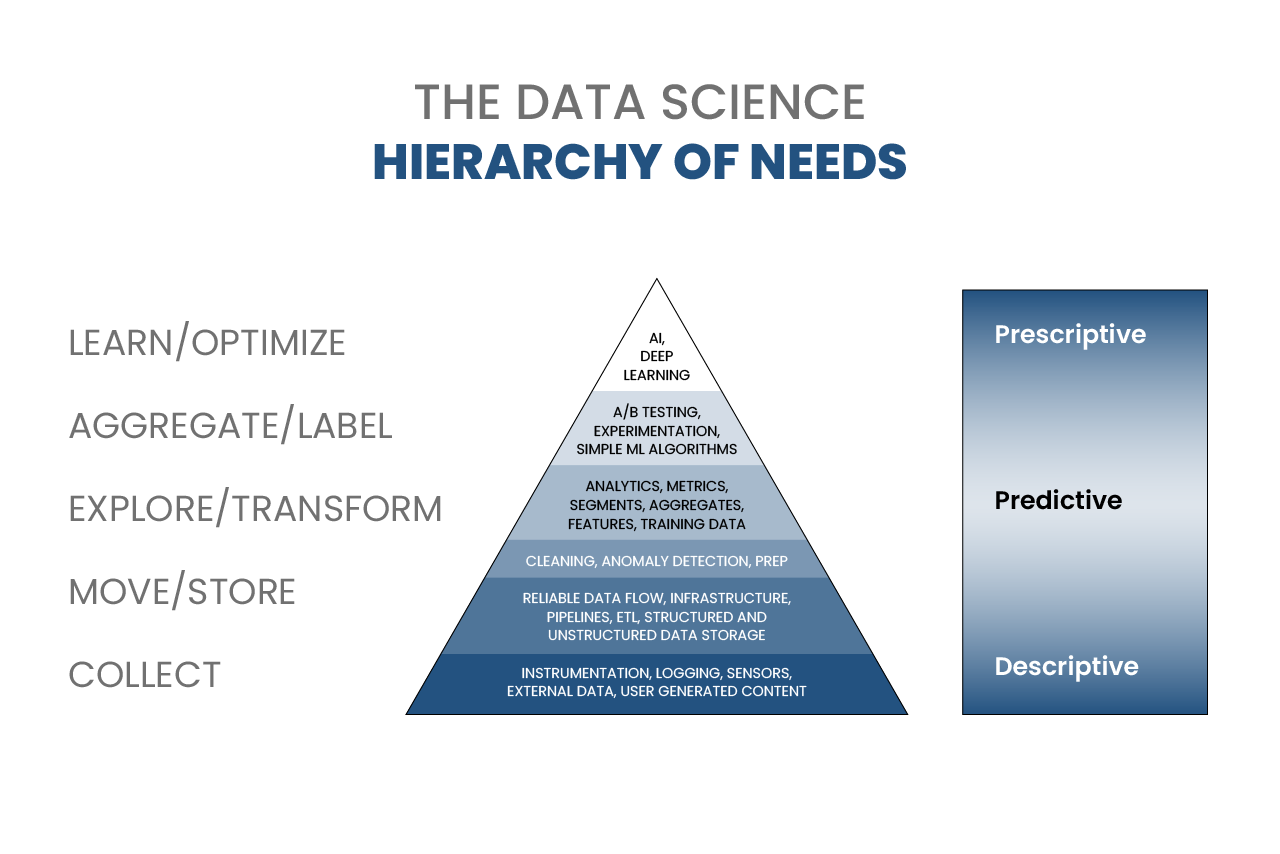
As the hype surrounding artificial intelligence (AI) increases, most companies are probably feeling behind the curve. Pressure to immediately implement AI into your business processes and catch up with others is strong. However, understanding your organization’s current level of AI adoption and readiness - your AI maturity level - is critical for putting together a plan to gradually progress towards your artificial intelligence goals.
Knowing your organization’s AI maturity is essential for making sound decisions concerning assessing the rewards and risks associated with implementing AI. Our article examines the data science hierarchy of needs and how understanding your current place in the hierarchy is relevant to the successful execution of your company’s AI vision and strategy.
Value of Implementing AI in Business
As business processes become more complicated by the day, organizations continue to explore AI’s role in improving their existing processes and applications. From automating decisions and classifying complex data to introducing actionable insights and generating compelling content, artificial intelligence can be trusted to accelerate these processes even when human investment and intervention are still necessary. There are best practices in processes to integrate AI into your business. Evaluation and review is a key part of that process.
A key part of that review, within a successful AI implementation strategy, is understanding how your company is positioned within the AI maturity framework, a model that helps users discover their company’s position on the potential growth and evolution curve. The results will give you the data you need to decide what specific actions you must take.
The AI Maturity Model and Why You Need It
The AI maturity model is a data and analytics framework that organizations can use to rate their current AI readiness and capabilities. Understanding your company’s place on the model offers valuable insights into the AI technologies, processes, and skills you need to develop, manage and maintain an AI-based system, besides moderating any potential risks linked to their development and consumption.
There’s a danger when an organization doesn’t clearly understand its AI readiness and capabilities or how to harness its potential success. They could explore their AI initiatives using incorrect pilot projects or make wrong assumptions regarding data availability, their readiness to deploy an AI-based system, or the results they expect the technology to deliver.
Using the AI maturity model helps organizations avert failures that could otherwise cause a loss of confidence in artificial intelligence and pour cold water into their aspirations. When contemplating using AI in your company, you want to remember that AI maturity involves data maturity (having the proper infrastructure) and analytics maturity (the ability to apply analytics to new and existing data).
Is your organization ready for AI?
When considering the use of AI in the organization, it’s important to remember two things: not every task needs to be automated, and automation becomes more valuable in the long term. Without automation, the only growth option is hiring more team members. Machine learning algorithms help process data in ways impossible to achieve before. Of course, mathematics has been there for years, but the lack of relevant data and computing power rendered it unviable. Understanding where you are today enables you to discover your best starting point and where you need to focus your efforts.
The Data Science Hierarchy of Needs

Image credit: Monica Rogati.
Originally introduced by data science advisor Monica Rogati in 2017 and patterned after Maslow’s hierarchy of needs - the visual pyramid model that demonstrates foundational requirements required before one can realize self-actualization - the data science hierarchy of needs has artificial intelligence at the top. Data literacy, collection, infrastructure, etc., make up the foundational layers of the data science pyramid.
The realization that AI maturity doesn’t happen overnight is why data-driven organizations like Apple, Amazon, Google, and Facebook, have succeeded where others failed. Growing and evolving as they go through the various stages in the data science hierarchy of needs enabled them to extract value and embed AI methodology into the core of their data strategies and holistic business processes.
This is why Gigster offers different artificial intelligence service levels based on a company’s level of AI maturity and their place in the data science hierarchy of needs.
Artificial intelligence, like all other fast-advancing technologies, can bring massive changes in how companies handle business processes, but only if organizations are prepared for AI-driven operations. Suppose you’re going to find your way into becoming data-driven and avoid getting stalled in your data science journey.
Different Stages of Artificial Intelligence
In that case, you need to understand where your company is in the growth stages based on the hierarchy of data-driven needs. In most cases, you must sufficiently satisfy the lower (primal) needs before entering the next phase of AI transformation.
Gigster recently launched specific AI service packages for the different stages of AI needs, so we are able to adapt to your scale and pace to meet you where you are and help you progress upwards.
Read More: How AI Shapes the Future of Critical Thinking
First Level, Part 1 - Collection
Data collection - which involves collecting the information your desired program needs to perform - forms the foundational level of the data science hierarchy of needs. Some essential components at this level include digitizing your data, sourcing data from external parties, or conducting experiments to generate new data. If you deal with user-oriented products, you may want to create a system that logs relevant user interactions.
The progress towards digital transformation can be slowed due to a lack of talent or investment in big data and analytics which slow down efforts to become data driven. When Gigster works with clients at this stage, we determine what their end goals or pain points are, and work to improve data collection based on what data they will need once they progress further up the hierarchy.
First Level, Part 2 - Storage
At this stage, the data you collected earlier is compiled and stored to be accessible to other users. The data should be stored in infrastructure that enables it to flow securely between pipelines and be protected against digital threats. Most organizations depend upon their ability to move data between physical servers and other forms of storage to cloud-based storage for company-wide access.
Gigster believes in building AI from the ground up. Beyond simply having the right data, that data needs to be in the right platform to align with future cloud migrations and architecture stages.
The first level of the hierarchy focuses on having the right data in place. Level 2 is all about preparing and understanding your data.
Second Level, Part 1 - Transformation
This stage involves implementing data cleaning, so there is consistent formatting and removal of any wrong entries within the dataset. Organizations also conduct tests to detect anomalies and identify data points inconsistent with expected patterns. Data transformation also includes the initial stages of analysis during data exploration when organizations visually analyze any components that a conventional management system fails to detect.
Second Level, Part 2 - Aggregation
The advanced processes of labeling information and implementing the basic analytics happen at the data aggregation stage, so information is streamlined better. The organization uses reports and dashboard metrics to gauge essential KPIs at this stage. Implementing a practical labeling system enables users to access the information they seek and analyze the required components of a dataset.
Second Level, Part 3 - Analysis
This stage incorporates more advanced data analysis procedures like data mining as it involves using database systems and statistics to identify hidden anomalies in large datasets so the organization can accurately predict its performance. The resultant descriptive and diagnostic analytics enable software engineers to evaluate what happened besides understanding why events occur. The outcomes allow them to make the necessary adjustments that ensure programs deliver the desired outcomes.
Gigster AI Infuse is ideal for organizations that already have the right data in place and are ready to leverage mature cloud APIs, models and platforms. The level 2 priorities are often done as pre-work for our AI-based projects at this stage but also may apply to companies that simply want to better leverage their data through custom databoards or integrations.
Third Level - Optimization
Data optimization is at the apex level of the pyramid and incorporates advanced technologies like machine learning and artificial intelligence to predict and respond to future events. By analyzing all the stored data, the organization can revise algorithms and deliver accurate responses besides studying the circumstances required for a particular outcome. By applying these principles, organizations automate processes and retain a competitive edge in their industries.
Some companies have already reached the higher levels of the hierarchy and are ready to expand to more strategic, company-transforming initiatives with AI and machine learning.
Gigster also has a service offering that caters to more ML-experienced companies to help them take the next step as well as ideation and planning-focused services for companies just starting their journeys.
An Ongoing Improvement Process
Applying the data science hierarchy involves a process, but organizations can make necessary adjustments based on individual needs and budgets. While some organizations can move step by step, others can combine different stages based on their circumstances. Using the model should be seen as a part of an ongoing improvement process where you’re free to revisit previous steps as may become necessary since data science is more of a continuous process than linear.
